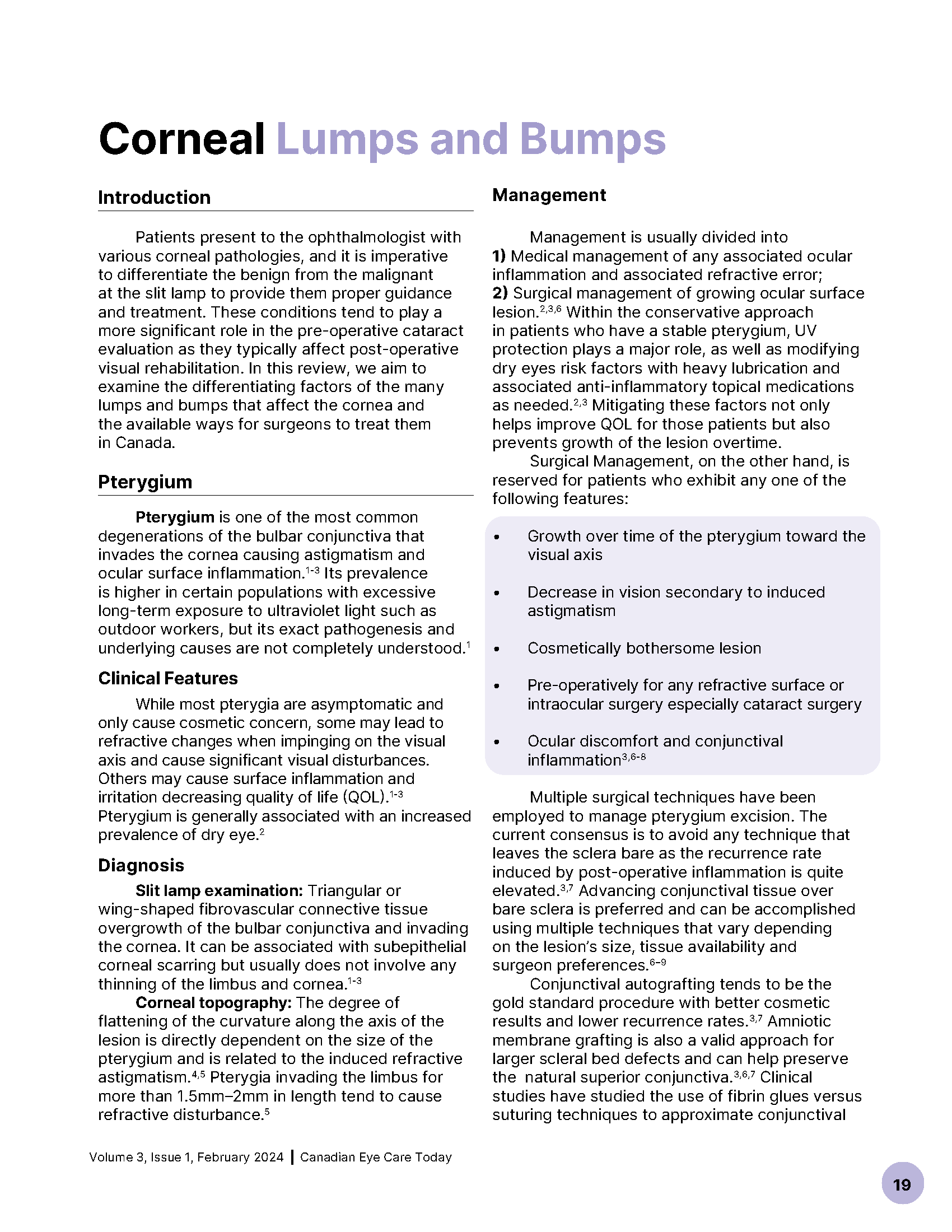Corneal Lumps and Bumps
Abstract
Patients present to the ophthalmologist with various corneal pathologies, and it is imperative to differentiate the benign from the malignant at the slit lamp to provide them proper guidance and treatment. These conditions tend to play a more significant role in the pre-operative cataract evaluation as they typically affect post-operative visual rehabilitation. In this review, we aim to examine the differentiating factors of the many lumps and bumps that affect the cornea and the available ways for surgeons to treat them in Canada.
References
Rezvan F, Khabazkhoob M, Hooshmand E et al. Prevalence and risk factors of pterygium: a systematic review and meta-analysis. Surv Ophthalmol [Internet]. 2018 Sep 1 [cited 2024 Jan 3];63(5):719-35. Available from: http://www.surveyophthalmol.com/article/S0039625717302655/fulltext
Linaburg T, Choi D, Bunya VY et al. Systematic Review: Effects of pterygium and pingueculum on the ocular surface and efficacy of surgical excision. Cornea. 2021 Feb 1;40(2):258-267.
Shahraki T, Arabi A, Feizi S. Pterygium: an update on pathophysiology, clinical features, and management. Vol. 13, Therapeutic Advances in Ophthalmology. SAGE Publications Ltd; 2021.
Levinger E, Sorkin N, Sella S et al. Posterior corneal surface changes after pterygium excision surgery [Internet]. 2020. Available from: www.corneajrnl.com
Bahar I, Loya N, Weinberger D, et al. Effect of pterygium surgery on corneal topography: A prospective study. Cornea. 2004 Mar;23(2):113-117.
Patel ED, Rhee MK. Surgical Techniques and Adjuvants for the Management of Pterygium. Vol. 48, Eye and Contact Lens. Lippincott Williams and Wilkins; 2022. p. 3–13.
Janson BJ, Sikder S. Surgical Management of Pterygium [Internet]. 2014. Available from: www.theocularsurface.com
Sabater-Cruz N DBMRJ et al. Postoperative treatment compliance rate and complications with two different protocols after pterygium excision and conjunctival autografting. Eur J Ophthalmol. 2021 May;31(3):932-937.
Taher NO, Alnabihi AN, Hersi RM et al. Amniotic membrane transplantation and conjunctival autograft combined with mitomycin C for the management of primary pterygium: A systematic review and meta-analysis. Front Med 2002;9.
Ghiasian L, Samavat B, Hadi Y et al. Recurrent pterygium: A review. J Curr Ophthalmol. 2022 Jan 6;33(4):367-378.
Kozma K, Dömötör ZR, Csutak A et al. Topical pharmacotherapy for ocular surface squamous neoplasia: systematic review and meta-analysis. Sci Rep. 2022 Dec 1;12(1).
Gichuhi S, Ohnuma S ichi, Sagoo MS et al. Pathophysiology of ocular surface squamous neoplasia. Vol. 129, Experimental Eye Research. Academic Press; 2014. p. 172–82.
Lloyd HWCM, Arunga S, Twinamasiko A et al. Predictors of Ocular Surface Squamous Neoplasia and Conjunctival Squamous Cell Carcinoma among Ugandan Patients: A Hospital-based Study. 2019; Available from: www.meajo.org
Wylegala A, Sripawadkul W, Zein M et al. Topical 1% 5-fluorouracil eye drops as primary treatment for ocular surface squamous neoplasia: Long-term follow-up study. Ocul Surf. 2023;27:67-74.
Kieval JZ, Karp CL, Shousha MA, Galor A et al. Ultra-high resolution optical coherence tomography for differentiation of ocular surface squamous neoplasia and pterygia. Ophthalmology. 2012;119(3):481-486.
Monroy D, Serrano A, Galor A, Karp CL. Medical treatment for ocular surface squamous neoplasia. Eye. 2023;37(5):885-893.
Yeoh CHY, Lee JJR, Lim BXH et al. The management of ocular surface squamous neoplasia (OSSN). International Journal of Molecular Sciences. MDPI; 2023.
Urbinati F, Borroni D, Rodríguez-Calvo-de-Mora M et al. Pseudopterygium: An algorithm approach based on the current evidence. Diagnostics. 2022 July 30;12(8):1843.
Ravichandran S, Natarajan R, Janarthanam J. Pterygium versus pseudo-pterygium in black and white. Indian J Ophthalmol. 2023;3(4):1206.
Farjo AA, Halperin GI, Syed N, et al. Salzmann’s nodular corneal degeneration clinical characteristics and surgical outcomes. Cornea. 2006 Jan;25(1):11-15.
Maharana PK, Sharma N, Das S, Agarwal T et al. Salzmann’s Nodular Degeneration [Internet]. 2016. Available from: www.theocularsurface.com
Paranjpe V, Galor A, Monsalve P, et al. Salzmann nodular degeneration: Prevalence, impact, and management strategies. Vol. 13, Clinical Ophthalmology. Dove Medical Press Ltd; 2019. p. 1305-1314.
Raber IM, Eagle RC. Peripheral Hypertrophic Subepithelial Corneal Degeneration [Internet]. 2021. Available from: www.corneajrnl.com
Järventausta PJ, Tervo TMT, Kivelä T et al. Peripheral hypertrophic subepithelial corneal degeneration – clinical and histopathological features. Acta Ophthalmologica (Oxford, England). 2014;92(8):774-782.
Hamada S, Darrad K, McDonnell PJ. Salzmann’s nodular corneal degeneration (SNCD): Clinical findings, risk factors, prognosis and the role of previous contact lens wear. Contact Lens and Anterior Eye. 2011 Aug;34(4):173-178.
Das S, Langenbucher A, Pogorelov P et al. Long-term outcome of excimer laser phototherapeutic keratectomy for treatment of Salzmann’s nodular degeneration. J Cataract Refract Surg. 2005;31(7):1386-1391.
Bowers PJ, Price MO, Zeldes SS et al. Superficial keratectomy with mitomycin-C for the treatment of Salzmann’s nodules. J Cataract Refract Surg. 2003 Jul 1;29(7):1302-1306.
Reddy JC, Rapuano CJ, Felipe AF et al. Quality of vision after excimer laser phototherapeutic keratectomy with intraoperative mitomycin-c for Salzmann nodular degeneration. Eye Contact Lens. 2014;40(4):213-219.
Goerlitz-Jessen MF, Gupta PK, Kim T. Impact of epithelial basement membrane dystrophy and Salzmann nodular degeneration on biometry measurements. J Cataract Refract Surg. 2019 Aug 1;45(8):1119-1123.

Downloads
Published
How to Cite
Issue
Section
License
Copyright (c) 2024 Canadian Eye Care Today

This work is licensed under a Creative Commons Attribution-NonCommercial-NoDerivatives 4.0 International License.
